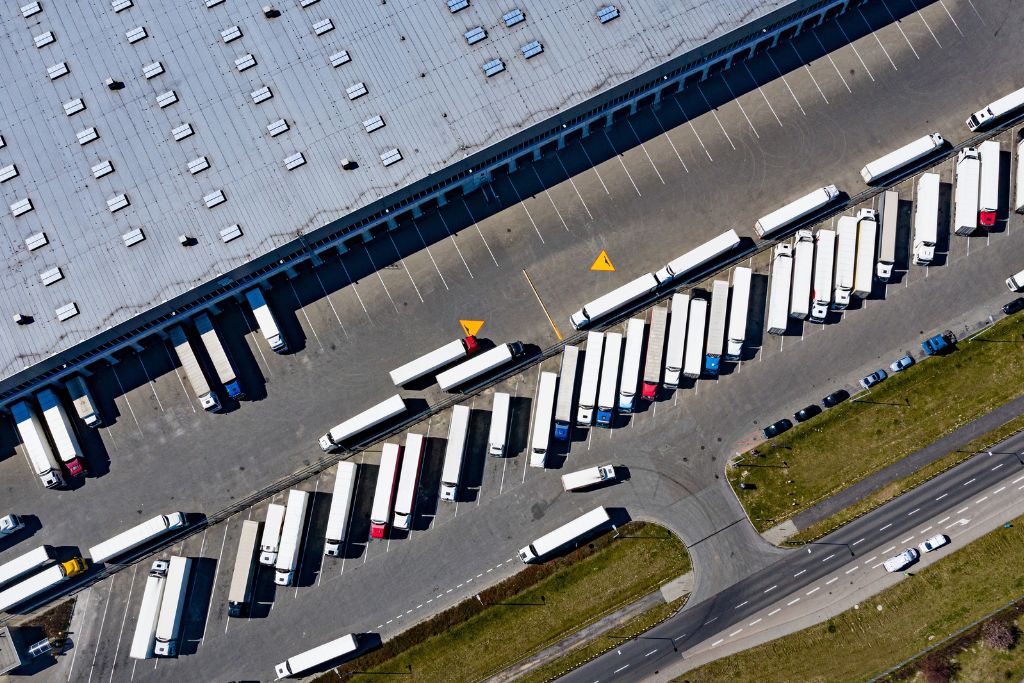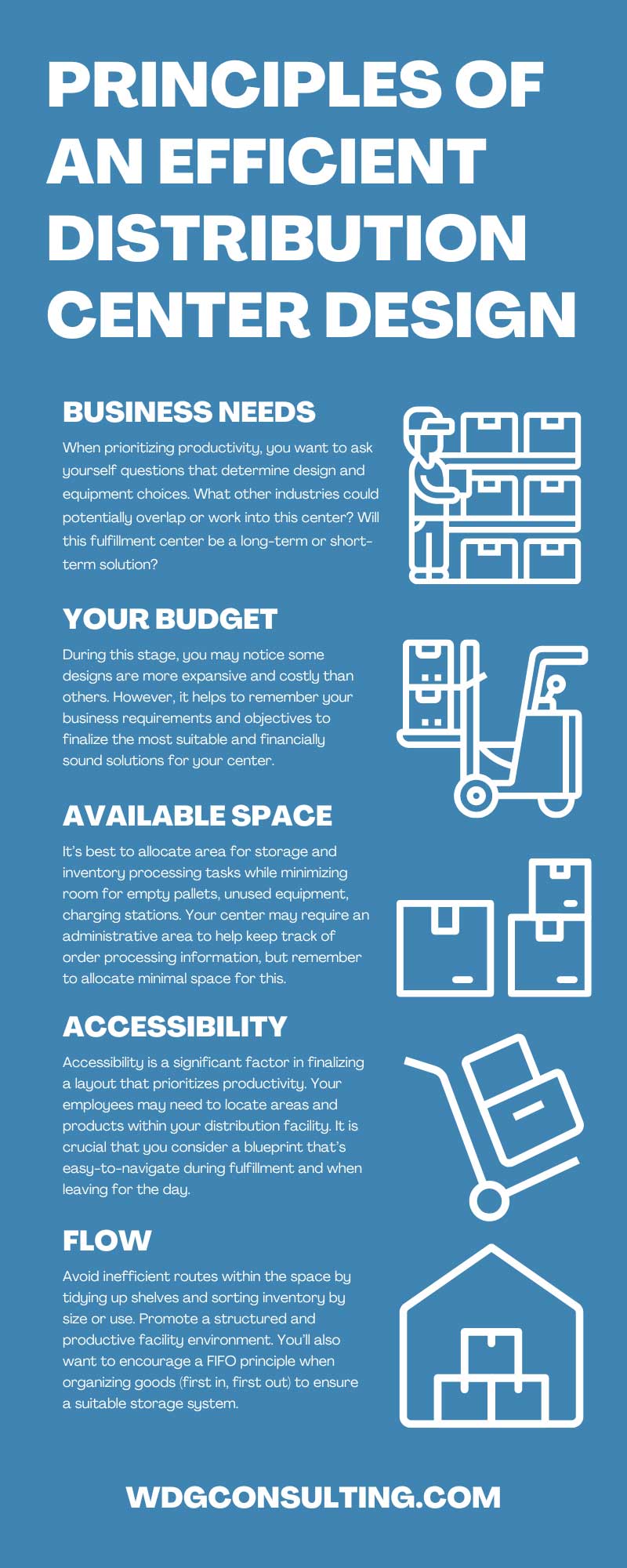
A distribution center’s layout is an essential element to assess during its establishment because you want to use the opportunity to maximize and optimize the space. Furthermore, determining a proper design allows you to expand and scale to accommodate your business needs during growth.
That said, outlining a dynamic blueprint can be a complex process. There are so many factors that could affect what you choose to add into your business space. In this article, we’ll discuss eight principles of an efficient distribution center design. You will learn the importance of a blueprint that can influence best practices during this stage.
The Importance of a Practical Layout
When it comes to designing a practical layout, it helps to understand its impact on productivity and efficiency during a typical day’s operations. The blueprint should accommodate processes in a fashion that displays a logical sequence that enables rapid order fulfillment.
Strategically planning your distribution center layout also provides accessibility to assets and minimizes delivery times while reducing expenses.
Furthermore, evaluating all requirements based on your business mission is a priority during the planning phase. Making brash changes during construction can lead to additional costs.
Principles To Remember
Below you’ll discover principles serving as a guideline to help establish an efficient distribution center layout. Like a warehouse layout, the center’s outline should streamline operations without inconveniencing individuals involved.
Business Needs
Your business needs and main objectives impact your project’s approach. While your main objective may change over time to accommodate your company’s future, one element remains consistent: productivity!
When prioritizing productivity, you want to ask yourself questions that determine design and equipment choices. What other industries could potentially overlap or work into this center? Will this fulfillment center be a long-term or short-term solution?
If the center has a long-term purpose, how long between each phase will you potentially need to re-design? Anticipating the answers to these questions helps set the initial foundation of an efficient distribution center by determining the size, location, and any specific equipment needed to make your outline a reality.
With the shift towards omni-channel sales or sales through brick-and-mortar locations and online, you can anticipate your distribution centers to fulfill more at a lower cost.
Your Budget
Before you can determine the ideal layout for your fulfillment center, you’ll want to evaluate your budget. It’s the key determinant in your blueprint’s complexity.
During this stage, you may notice some designs are more expansive and costly than others. However, it helps to remember your business requirements and objectives to finalize the most suitable and financially sound solutions for your center.
Available Space
Space is an essential element when determining the most suitable outline of your distribution center. Maximizing your available space may promote optimal operational efficiency and improve inventory visibility and accessibility.
It helps to dedicate areas to shelving, installation capacities, and merchandise placement so that employees can locate what they need.
It’s best to allocate area for storage and inventory processing tasks while minimizing room for empty pallets, unused equipment, charging stations. Your center may require an administrative area to help keep track of order processing information, but remember to allocate minimal space for this.
Accessibility
Accessibility is a significant factor in finalizing a layout that prioritizes productivity. Your employees may need to locate areas and products within your distribution facility. It is crucial that you consider a blueprint that’s easy-to-navigate during fulfillment and when leaving for the day.
By taking accessibility into account, you can expect an improvement in order fulfillment, resulting in a satisfied clientele.
Flow
Flow and accessibility go hand-in-hand during order fulfillment. With a successful, uninterrupted flow of equipment, personnel, and inventory, you can ensure smooth functioning throughout your distribution facility.
Avoid inefficient routes within the space by tidying up shelves and sorting inventory by size or use. Promote a structured and productive facility environment. You’ll also want to encourage a FIFO principle when organizing goods (first in, first out) to ensure a suitable storage system.
Equipment
From lifting and packing resources to pallets and conveyors, there’s plenty of essential equipment in your fulfillment facility that could influence its final design.
Depending on your industry or business objectives, the center may require dock equipment like truck restraints, dock boards and plates, and yard ramps to facilitate inventory loading and unloading.
On the other hand, the center may also require material handling devices to automate cargo transfers, ultimately saving time and labor.
Personnel
Ultimately, the amount of personnel available to fulfill orders and carry out tasks plays a significant role in your final design. It helps to know the adequate number needed, their skill sets, levels of training and shifts to ensure that you accommodate their needs while prioritizing productivity.
Safety
When designing your distribution facility’s layout, remember that your employees’ safety is the utmost priority. Your final blueprint should abide by authority guidelines to avoid fines and legal concerns while protecting your teams, equipment, and inventory.
Additional Elements To Consider
Distribution center principles don’t end at the design. There are a couple of additional elements to consider that may facilitate your approach during the planning phase.
IT System and Technology
Most distribution centers have some form of technology. You’ll want to include IT systems, software and other technologies into your planning process.
For example, inventory management systems and waste prediction models can help you budget correctly for a heavy production/shipping month.
Predictive analytic tools through IT systems can help drive decision making further. Automated equipment like tracks, conveyors or sorters can help with manual production.
Volume of Goods
It also helps to understand the inventory that comes in and leaves your facility. It would be wise to have estimates on the quantity of products or equipment stored compared to quantity of products that are incoming and outgoing.
Distribution centers are large investments that should have minimal mistakes. Grow too fast and you may find yourself out of capital; move too slow and you may be unable to keep up with the volume moving in and out.
A well-executed blueprint can go a long way when establishing a distribution center for your business. Remembering some of these principles of distribution center design can ensure that you achieve optimal utilization of your resources while boosting productivity and improving fulfillment rates.
While you can reference these suggestions during all stages to ensure the best result, it helps to have a professional’s assistance during the process. WDG Consulting provides site selection consultants with superior qualifications in location strategy. Our experts have expertise and exclusive resources to evaluate every angle of your business, based on your industry.

